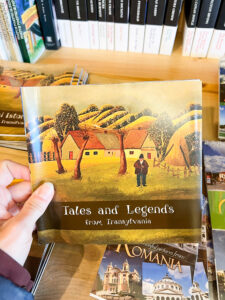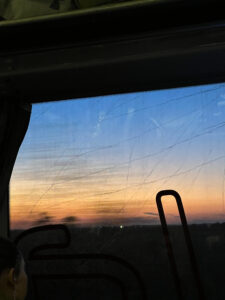
I’ve always been fascinated by paranormal tourism. I’m interested in the sociological component of legends and ghost stories and the way these things can shape communities. I love observing what “paranormal tourism” and “dark tourism” reveal about the places promoting them. Horror stories are not interesting to me, and I hate gore for the sake of shock value—it’s the subtleties I’m interested in, the details tinged with mystery and unanswered questions. I’m not sure what my own beliefs are about anything that might fall into the category of “paranormal,” but my beliefs feel beside the point. It’s everyone else’s beliefs that I’m interested in. I think my personality fits this aesthetic—a Scorpio who desires at all times to be reading something beautiful and mysterious under fall foliage. I want to hear every legend, every spooky story. I want fall colors and cold nights and campfires and quiet voices. I want ghost tours and unexplained myths and what you are embarrassed to admit you’re superstitious of. I want gothic architecture, New England Halloweens, and New Orleans Voodoo ceremonies. And so, it was always obvious to me that I needed to visit Transylvania in October.
It’s hard for me to name a place more associated with mystery than Transylvania. But prior to visiting, I had no idea whether this was an assumption only held by outsiders because of the media. How do the Transylvanian people feel about it? How commercialized would this tourism be? How many different Dracula shirts would the souvenir shops sell? I was surprised by what I found.
In my previous post, I wrote about Brasov, one of my favorite cities I visited in Europe. I figured that no trip to Transylvania could be complete without a visit to the famous Bran Castle, so I took a half-day tour there with a guide. If you read my previous post, you know that Bran Castle is famous for being the “Dracula Castle”—the castle that Bram Stoker used for inspiration when he wrote the novel. But Bram Stoker never visited Romania—he lived in Ireland, saw photos of the castle in a book, and thought the castle, region, and legends fit the aesthetic he wanted. BUT there was a real Dracula. We know him as Vlad the Impaler.

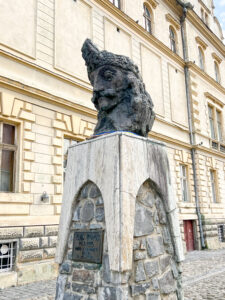
Vlad the Impaler was also known as Vlad Dracula, son of the dragon, because his father was a member of the Order of the Dragon. He ruled the region that was then called Wallachia back in the 1400s. He truly did impale his victims—some estimate more than 80,000 of them. Based on everything I’d heard about Vlad the Impaler, he sounded far scarier than any fiction vampire story. But many locals still regard him as a hero because even though he was vicious in his methods of defeating enemies, his aim was to protect his country from the Ottomans who were trying to take over the country. In other words, locals would say that he was only cruel to the bad guys who deserved it. It was his enemies who tried to paint him as an evil tyrant, and stories began to spread about the blood-thirsty Dracula. A few centuries later and 2,000 miles away, Bram Stoker heard of these stories along with older Romanian mythology, and an idea for a novel was born.
Historians don’t actually know if Vlad the Impaler ever visited Bran Castle. Instead, the castle was the home of the beloved Queen Maria, considered by many to be the unifier and savior of modern Romania. She left the castle to her daughter, Ileana. I wondered how Bran Castle would handle this predicament that they never asked to be put in—being famous for a vampire story that has essentially nothing to do with them. I wondered if they would capitalize on this being the reason so many tourists visit or if they’d try to brush it aside and try to captivate visitors with the real history instead.
They aimed for a balance. In every room in the castle, there were photos of the royal family, and alongside them easels and plaques sharing info about Bram Stoker and the phenomenon of Dracula. The castle’s atmosphere really lends itself to the spook-seekers. It’s all stone and small passages and nestled in a mountainside. Our guide called the castle “humble and cozy.” And while it is beautiful, I don’t know that I’ve ever heard gothic architecture referred to as “cozy.” A few rooms near the top of the castle are devoted to the Romanian “dreads”–the paranormal creatures and spirits prominent in Romanian mythology. There are the iele—faeries with seductive power over men, the santoaderi—men with long hooves who might kidnap you, the solomonari—a wizard who rides a dragon and controls the weather, ghosts, werewolves, and the strigoi—spirits who rise from the grave, can take the form of animals, and seek the blood of their victims…something very much like what we would call a vampire. The castle did a great job explaining what myths and history Bram Stoker was probably exposed to and how Prince Vlad evolved into the Hollywood villain that we know him as today.
Our guide had nothing to say about these rooms. “Take your time and look,” he said and told us he’d be waiting for us in the next section. “For those who come to visit Bran Castle, they have to satisfy some kind of… adrenaline,” he said. “These rooms are for them.”

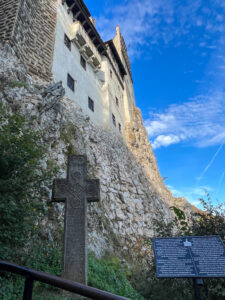
As it turns out, if you’re looking for a commercialized spooky tourism destination with ghost tours and dressed up guides and pub crawls with Halloween themed cocktails, this is not it. The tour guide told us that some people (in fact, a considerable percentage of tourist who visit Romania) come here on a “haunted Transylvania” quest, and they find themselves disappointed. I would have expected the town to capitalize on the opportunity far more than they did, and the lack of commercialism was a pleasant surprise. Other than a lot of Dracula magnets in souvenir shops and a few “haunted house” events for Halloween near the castle (plus the castle’s big Halloween party they host every year), I didn’t find the commercialization I expected. I didn’t find many ghost tours in Romania—nowhere near as many as I found in most major cities in Europe or America. And a lot of guides didn’t have much to say on the subject.
Our guide didn’t talk about Bram Stoker except to say that he never visited Transylvania and that he only liked the word. He talked a little about Vlad the Impaler, but only in passing. Our guide tried hard to paint the castle as a bright and cheery place. I felt his disdain even though he denied it when I tried to gently prod later.
“Do you find all the Dracula tourists frustrating?” I asked him.
“No, no,” he said. No further comments.
And on one level, I get it. I understand not wanting to treat this fictional story from an author with no connection to this place as if it’s an integral part of its history or significance. The history is rich enough without embellishments or fabrications. And maybe it’s because I’m a former English teacher, but I feel there’s something important to acknowledge here: regardless of the historical facts, this place inspired a story that ended up becoming the prototype for an entire genre. Though the story is entirely fiction, the source material that inspired it still belongs to this region. There have been something like 450 films and books inspired by Dracula, including every vampire story you’ve ever heard of. This is THE modern horror novel, the most-read horror story of all time. Let’s celebrate that. Let’s celebrate this work of art and the way it impacted literature and all of the art world. The guide said the book is very boring. The 450 artists who were inspired by it would perhaps disagree. Even though Bran Castle might not be exactly what some paranormal tourists are expecting, there’s nothing disappointing about it.
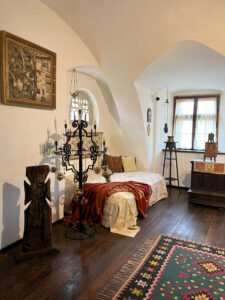
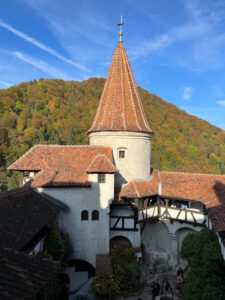
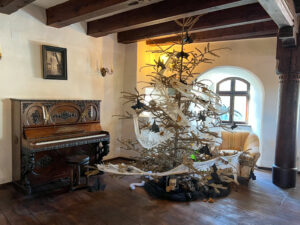
And also, there’s this… I don’t know a better way to say this except to say that Transylvania DID feel eerie. Not in a frightening way, but in a beautiful and mysterious way. Maybe it was the quietness there, or the fog rolling off the mountains. Maybe it was the fall colors or the wildness, the constant warnings not to stray too far off the paths because of the bears and wolves. There’s something about the beauty here that feels supernatural and otherworldly. It didn’t feel uninviting in its eeriness—it felt instead like a place that holds its secrets close.
After spending 3 nights in Brasov, I headed to Sighisoara, a small town just an hour away where Vlad the Impaler was born. I had heard that I would love Sighisoara, that it’s the most beautiful of all the towns in Transylvania. Most people visit on a day trip because the town is so small, but I decided to spend a night. I arrived after dark and had to find my way up to my tiny, private attic room in the hostel—a real life nightmare for the claustrophobic among us. I was ready for the quaintness I’d been promised, but Sighisoara turned out to be far more commercial than I expected.
Vlad the Impaler’s childhood home is now a restaurant, so of course I had to eat there (The food was fine and forgettable.) and pay the small fee to visit his childhood bedroom. The people here REALLY missed the memo about playing it cool the way Bran Castle does. They dropped a stuffed bat on a string on my head as I climbed the stairs, and at the top of the stairs I found myself in a room glowing with red light with a large plywood coffin sitting in the corner. A horror music soundtrack played over the speakers as I looked at the man lying in the coffin—the restaurant worker who had sprinted up the stairs in front of me as I paid my $2 fee, like perhaps I wouldn’t notice. I smiled at him, and he said, “Selfie?” The town was beautiful, but many things were closed for the season, and I would have been satisfied with a couple of hours there rather than an overnight visit.
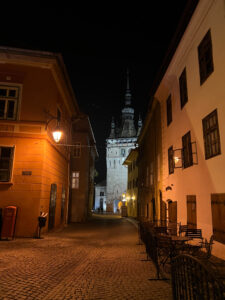
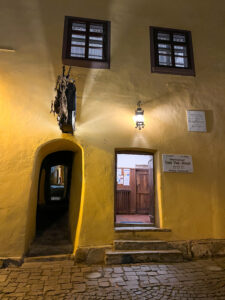
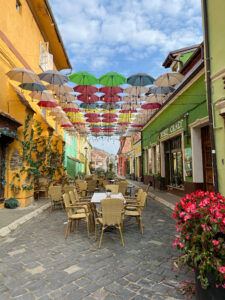

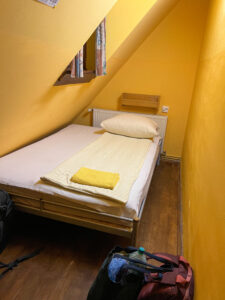
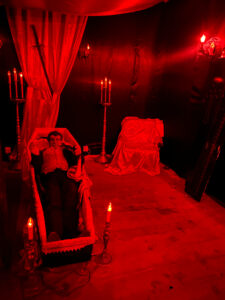

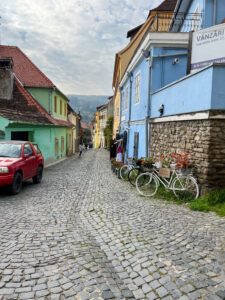
I got on a train and headed to Sibiu. Sibiu is an adorable Transylvanian town where the houses all have eyes. Or at least they look like eyes. People find this quite creepy, but the truth is that this was just a ventilation system for their attics. Sibiu was a European Capital of Culture in 2007, and it was easy to tell that a lot of money had gone into the effort. It felt more polished than Brasov, like it was geared to attract a slightly more upscale crowd. There was a film festival in town when I was there, and it felt very cosmopolitan and sophisticated. I stayed in two adorable Airbnbs (because neither was available for both nights of my stay), and both of my hosts were responsive and not ghosts. I climbed the bell tower and saw the Carpathian Mountains in the distance.
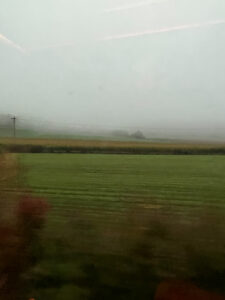
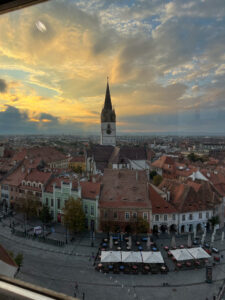

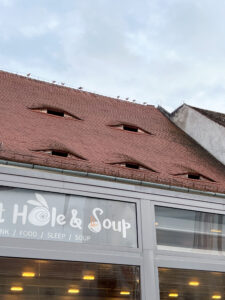


I walked in the fog and darkness of 5:00am to the train station to get to my last stop on my tour around Transylvania—Cluj Napoca. Cluj is the largest city in Transylvania and the second largest city in Romania. It’s a quirky university town, and not really known as a tourist destination. There were stilts-performers practicing their routine in the main square, and this felt very casually Transylvanian. There were a million bookstores and places like my favorite restaurant in town, Garlic – Bites and Tales, which was a tasteful nod to Dracula and a gorgeous restaurant with incredible food. There aren’t many big tourist attractions in Cluj, but one that I had on my list to visit was the Hoia-Baciu Forest.
Hoia-Baciu Forest is a large forest right outside the city of Cluj, and it’s often called the most haunted forest in the world. The rumors are that the forest is a portal to another dimension or perhaps a UFO hotspot and that people come back from it changed, or they don’t come back at all. There are tons and tons of first-hand reports of visitors to the forest coming out with creepy symptoms like fevers, headaches, rashes, burns, and hallucinations. (There’s been a lot of research on it, and some scientists think it’s something to do with radiation in the soil.) There are a lot of night tours offered where you can go with a guide and “enter if you dare.” And for the first time, maybe ever, I decided not to do it. I was, quite simply, too scared. And it’s not that I was afraid of the extraterrestrials or ghosts or monsters or whatever was supposedly going to try and capture me. Instead, I was afraid that if I set foot in the forest, I would IMAGINE a weird thing happening to me and psychosomatically make it happen. I’d creep myself out so much that I’d have hives for the next ten years. I don’t know what I believe about anything paranormal, but I DO know that my imagination is very good. Our brains might be the scariest places of all.
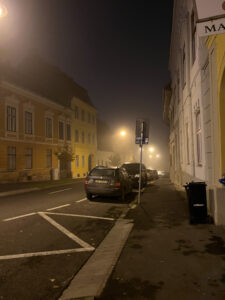

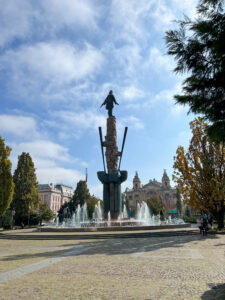

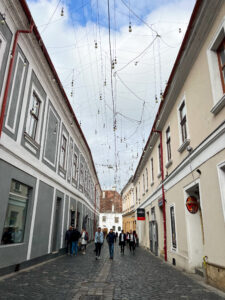


In Brasov, I asked the driver who brought me to the Bear Sanctuary whether people in the region really believe in any of the spooky legends. At first he said no, at least not anyone our age or the younger generations. Then he thought about it for a while before telling me about his grandmother. He told me that when he was young, his grandmother didn’t give him medicine—she brewed him herbal remedies instead, that she held a lot of superstitions, that this was a normal generational thing. I understood as he told me this that there is a fine line between, for instance, what we are willing to call a natural remedy and what we are bold enough to call a potion. We can paint stories the way we want to paint them while still telling the truth, but my driver didn’t fall into this trap of interpretation. He let me do it myself.
My driver told me that his grandma always said that the bad can only come in if you invite it in, so he closes that door in his mind. That’s what I thought about when I chose not to visit the woods.
The fact that the local people here keep their beliefs quiet makes it all the more interesting. The older generations here keep their superstitions close to them. I like that there’s mystery left here that feels untainted and untouchable.
